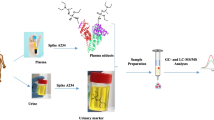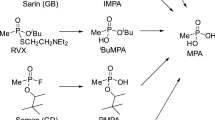Abstract
Although nerve agent use is prohibited, concerns remain for human exposure to nerve agents during decommissioning, research, and warfare. Exposure can be detected through the analysis of hydrolysis products in urine as well as blood. An analytical method to detect exposure to five nerve agents, including VX, VR (Russian VX), GB (sarin), GD (soman), and GF (cyclosarin), through the analysis of the hydrolysis products, which are the primary metabolites, in serum has been developed and characterized. This method uses solid-phase extraction coupled with high-performance liquid chromatography for separation and isotopic dilution tandem mass spectrometry for detection. An uncommon buffer of ammonium fluoride was used to enhance ionization and improve sensitivity when coupled with hydrophilic interaction liquid chromatography resulting in detection limits from 0.3 to 0.5 ng/mL. The assessment of two quality control samples demonstrated high accuracy (101–105 %) and high precision (5–8 %) for the detection of these five nerve agent hydrolysis products in serum.



Similar content being viewed by others
References
(1989) Medical aspects for chemical and biological warfare; Eds. Office of The Surgeon General: Washington DC
Pan H, Hu XZ, Jacobowitz DM, Chen C, McDonough J, Van Shura K, Lyman M, Marini AM (2012) Alpha-linolenic acid is a potent neuroprotective agent against soman-induced neuropathology. Neurotoxicology 33:1219–1229
Perkins MW, Pierre Z, Sabnekar P, Sciuto AM, Song J, Soojhawon I, Oguntayo S, Doctor BP, Nambiar MP (2012) Aerosolized delivery of oxime MMB-4 in combination with atropine sulfate protects against soman exposure in guinea pigs. Inhal Toxicol 24:539–549
Evans RA, Jakubowski EM, Muse WT, Matson K, Hulet SW, Mioduszewski RJ, Thomson SA, Totura AL, Renner JA, Crouse CL (2008) Quantification of sarin and cyclosarin metabolites isopropyl methylphosphonic acid and cyclohexyl methylphosphonic acid in minipig plasma using isotope-dilution and liquid chromatography-time-of-flight mass spectrometry. J Anal Toxicol 32:78–85
Tsuchihashi H, Katagi M, Nishikawa M, Tatsuno M (1998) Identification of metabolites of nerve agent VX in serum collected from a victim. J Anal Toxicol 22:383–388
Noort D, Hulst AG, Platenburg DH, Polhuijs M, Benschop HP (1998) Quantitative analysis of O-isopropyl methylphosphonic acid in serum samples of Japanese citizens allegedly exposed to sarin: estimation of internal dosage. Arch Toxicol 72:671–675
Barr JR, Driskell WJ, Aston LS, Martinez RA (2004) Quantitation of metabolites of the nerve agents sarin, soman, cyclohexylsarin, VX, and Russian VX in human urine using isotope-dilution gas chromatography-tandem mass spectrometry. J Anal Toxicol 28:372–378
Shih ML, Smith JR, McMonagle JD, Dolzine TW, Gresham VC (1991) Detection of metabolites of toxic alkylmethylphosphonates in biological samples. Biol Mass Spectrom 20:717–723
Driskell WJ, Shih M, Needham LL, Barr DB (2002) Quantitation of organophosphorus nerve agent metabolites in human urine using isotope dilution gas chromatography-tandem mass spectrometry. J Anal Toxicol 26:6–10
Swaim LL, Johnson RC, Zhou Y, Sandlin C, Barr JR (2008) Quantification of organophosphorus nerve agent metabolites using a reduced-volume, high-throughput sample processing format and liquid chromatography-tandem mass spectrometry. J Anal Toxicol 32:774–777
Mawhinney DB, Hamelin EI, Fraser R, Silva SS, Pavlopoulos AJ, Kobelski RJ (2007) The determination of organophosphonate nerve agent metabolites in human urine by hydrophilic interaction liquid chromatography tandem mass spectrometry. J Chromatogr B 852:235–243
Ciner FL, McCord CE, Plunkett RW Jr, Martin MF, Croley TR (2007) Isotope dilution LC/MS/MS for the detection of nerve agent exposure in urine. J Chromatogr B 846:42–50
Read RW, Black RM (1999) Rapid screening procedures for the hydrolysis products of chemical warfare agents using positive and negative ion liquid chromatography-mass spectrometry with atmospheric pressure chemical ionisation. J Chromatogr A 862:169–177
Kanaujia PK, Pardasani D, Tak V, Purohit AK, Dubey DK (2011) Selective enrichment of the degradation products of organophosphorus nerve agents by zirconia based solid-phase extraction. J Chromatogr A 1218:6612–6620
Li P, Hu B, Li X (2012) Zirconia coated stir bar sorptive extraction combined with large volume sample stacking capillary electrophoresis-indirect ultraviolet detection for the determination of chemical warfare agent degradation products in water samples. J Chromatogr A 1247:49–56
Mawhinney DB, Stanelle RD, Hamelin EI, Kobelski RJ (2007) Enhancing the response of alkyl methylphosphonic acids in negative electrospray ionization liquid chromatography tandem mass spectrometry by post-column addition of organic solvents. J Am Soc Mass Spectrom 18:1821–1826
Rannulu NS, Cole RB (2012) Novel fragmentation pathways of anionic adducts of steroids formed by electrospray anion attachment involving regioselective attachment, regiospecific decompositions, charge-induced pathways, and ion-dipole complex intermediates. J Am Soc Mass Spectrom 23:1558–1568
Yanes O, Tautenhahn R, Patti GJ, Siuzdak G (2011) Expanding coverage of the metabolome for global metabolite profiling. Anal Chem 83:2152–2161
(2001) Guidance for industry, “bioanalytical method validation”, Department of Health and Human Services, Food and Drug Administration
Taylor JK (1987) Quality assurance of chemical measurements. Boca Raton, CRC LLC
Disclaimer
The findings and conclusions in this report are those of the authors and do not necessarily represent the views of the Centers for Disease Control and Prevention. Use of trade names is for identification only and does not imply endorsement by the Centers for Disease Control and Prevention, the Public Health Service, or the US Department of Health and Human Services.
Author information
Authors and Affiliations
Corresponding author
Additional information
Published in the topical collection Analysis of Chemicals Relevant to the Chemical Weapons Convention with guest editors Marc-Michael Blum and R. V. S. Murty Mamidanna.
Rights and permissions
About this article
Cite this article
Hamelin, E.I., Schulze, N.D., Shaner, R.L. et al. Quantitation of five organophosphorus nerve agent metabolites in serum using hydrophilic interaction liquid chromatography and tandem mass spectrometry. Anal Bioanal Chem 406, 5195–5202 (2014). https://doi.org/10.1007/s00216-014-7702-2
Received:
Revised:
Accepted:
Published:
Issue Date:
DOI: https://doi.org/10.1007/s00216-014-7702-2




